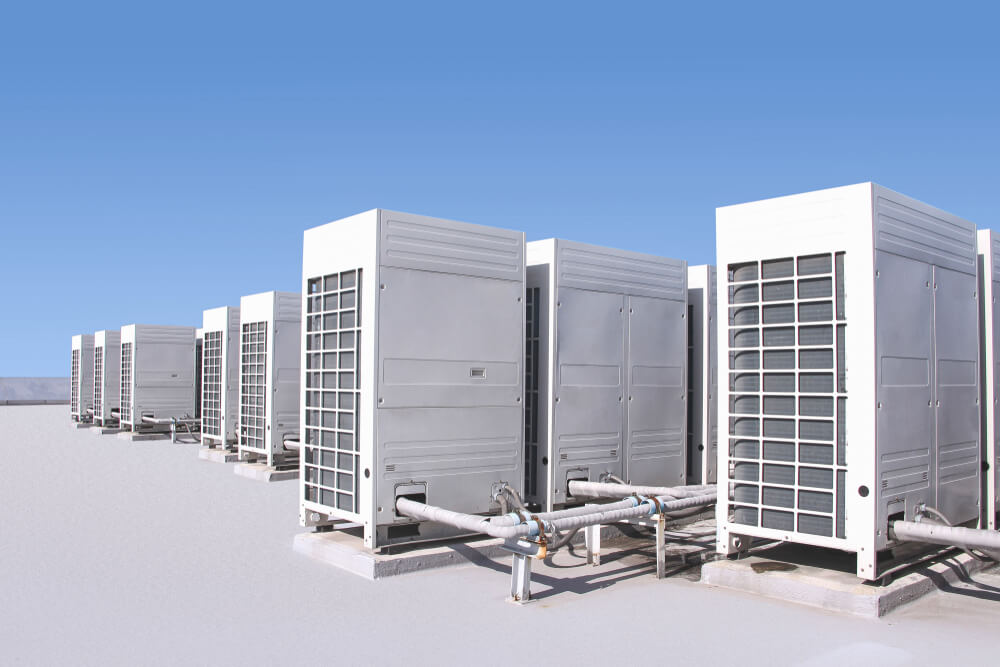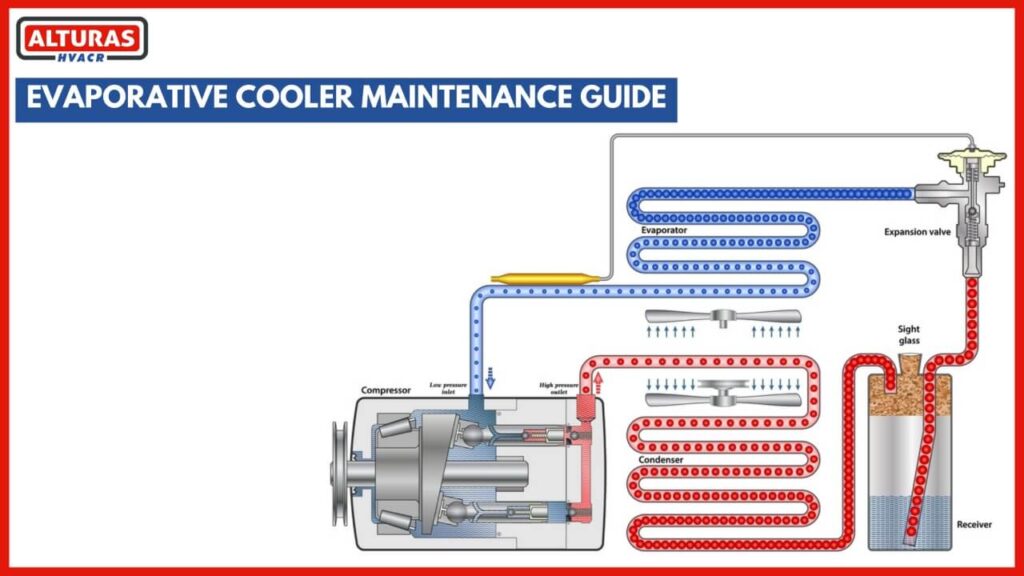Not to forget and never ignore that the routine maintenance of any sort of evaporative cooler would always keep the unit running at its best capacity, it would keep your space cooler in the best possible way if it is taken care of properly. All the evaporative cooler units use water to help cool the space instead of refrigerant like all other traditional air conditioners. Routine draining and cleaning will always help in preventing any sort of mold growth in your evaporative cooler.
Step-By-Step Evaporative Cooler Maintenance Checklist

Here is how you can maintain your evaporative cooler unit once every two or three months for ideal functioning and improved effectiveness:
- Remove the protective winter covers from the unit.
- Take out any insulating materials, such as newspapers, from inside the unit.
- Install new cooler pads.
- Clean the water reservoir located beneath the unit.
- Repaint the reservoir if you notice any rust.
- Verify the float valve is functioning properly.
- Ensure there are no leaks in the water supply.
- Inspect the motor, fan belt, and bearings.
- Check for any unusual noises.
- Run the unit and confirm there are no dry spots on the pads.
- Ensure the cooling temperature is correct.
Clean Or Replace the Pads
You must consider changing your evaporative cooler pads regularly as it is one of the most important components of maintaining your evaporative cooler. Whenever you notice that the pads are damaged, you must remove them and carefully clean the pad frames before installing new pads. Any sort of mineral deposits that are left behind must be removed with a wire brush and a mild soap and water mixture. These pads would eventually break or become useless, so it is very important to keep up with replacing them as needed.
Regularly Clean The Water Tank
The water tank is yet another very critical component of the evaporative cooler that should be properly cleaned to make your evaporator cooler function at the best of its capacity. A pump is used to pump water from this location to keep the cooling pads moist and efficient. There are chances that the water that is pushed to the cooling pads will not be as clean as it has to be if the tank is not kept clean properly and timely. Because of this condition, the quality of air that the evaporative cooler throws in your home will be decreased as well.
Also, it is very important to remember that the water tank tends to get polluted in any circumstances. Because of a lack of proper cleaning, the tank can easily become a breeding ground for mosquitoes, germs, bacteria, and other harmful microorganisms. Once you remove the water from the tank, you must properly and thoroughly rinse it with mild soapy water.
Remove All Those Stuck Calcium Deposits
Whenever we talk about evaporative cooler unit pads, one of the most often asked questions that you would hear would be, “How do you remove calcium deposits from cooler pads?” well per our experience the most effective method is to thoroughly clean the interior of the unit frequently to prevent all these deposits from even developing there. All these mineral deposits can be removed by using a simple blend of white vinegar with water. Throughout the season, you should clean the water tank at least once a month to prevent minerals from gathering inside.
We at Alturas Contractors would recommend washing the filter once or twice a week with a light detergent and warm water to keep the pads in good condition as well.
Also Read: Common Types of Evaporative Coolers
Examine Electrical Components and Motor Belt
Try to take some time so that you can visually inspect all electrical wiring and any sort of switches that are there on the device for signs of old insulation or poor connection quality. You should replace any worn or broken parts you come across. You must make a thorough inspection for any kind of cracking or other signs of damage. You can slightly lubricate all of the motor’s working parts to make sure that they can turn easily without any hurdles.
Check the tension of the air conditioner’s belt to make sure it is properly tight. If you find the need, tighten the motor nuts until the belts are properly tensioned. When mild pressure from your hands depresses the belt roughly an inch near the middle of the belt, you’ll know you’ve achieved adequate belt tension.
Weekly Evaporative Cooler Maintenance

As we all know an evaporative cooler is not a sealed system, and the water that circulates through the filter pad would get dirty at some point. It may get polluted by bacteria, that may become airborne as the fan blows through the pad.
To keep your cooler clean, you should drain the water reservoir at least once in the whole week. Usually, standalone units have a drain plug, that may be located on the bottom of the housing. You must turn off the unit, open the drain plug and let all the water drain, then turn on the fan to dry out the filter pad. This would help prevent mold growth in the pad. Also, standalone evaporative cooler units need to be replenished with fresh water regularly. The amount you need to add would depend on how often you use the cooler. It would be a good idea to check the reservoir level every day if you use the cooler frequently.
You don’t have to worry about water contamination if you have a rooftop unit connected to a supply pipe and a drain, because fresh water is always flowing through the pads.
Monthly Evaporative Cooler Maintenance

Even though the air circulating through the filter pads is a natural mold and mildew warning, some mold is bound to get a foothold during the hot summer. In case you allow the filter to dry out completely when you change the water would also be a good way to keep it under control, but to be on the safer side, it would be best to remove the filter and clean it at least once a month.
Let the filter dry, then saturate it with a 50-50 mixture of vinegar and water and let it dry out again. As we know vinegar is a natural disinfectant that would not create any toxic byproducts, which would make it better than bleach for this purpose. You can also use vinegar as a homemade swamp cooler deodorizer. When you have the filter out, clean the inside of the filter compartment, as well as the water reservoir, with soap and water.
Following the above comprehensive checklist can streamline the servicing of evaporative coolers, reducing the burden and ensuring a more efficient process.
If you are looking for evaporative cooler repair and maintenance service providers in Los Angeles and surrounding areas, call Alturas Contractors. We will then provide you with an estimated cost depending upon the issue. However, we have made a flexible budget for our customers. Especially, when it comes to evaporative cooler repairs, so you need not worry.
Conclusion
To maintain your evaporative cooler effectively and ensure it functions as an energy-efficient alternative to an air conditioner, regular cooler maintenance is essential. Checking the fan belt, motor, and water pump, as these components keep the unit running smoothly. Inspect and replace cooler pads regularly, as they can become clogged with mineral deposits over time, reducing cooling efficiency. Be sure to monitor the water level and water quality by periodically draining the water from the water reservoir and cleaning the water tank to prevent buildup. Regularly clean the unit, check water levels, and inspect the motor and pump to ensure efficient operation of your evaporative cooler.
The pad frame and water supply should also be checked, ensuring fresh water flows across the cooling pads. Cleaning the unit and inspecting the swamp cooler’s water pump and warm water circulation will help extend the life of the system. With proper care, your evaporative cooler will continue to provide reliable, eco-friendly cooling for many seasons.
Common FAQs about Swamp Cooler Maintenance Checklist
How to clean calcium from a swamp cooler?
The best cleaner is a simple mix of white vinegar and water. It would help if you clean the water pan reservoir at the bottom of the cooling unit at least once a month throughout the season to prevent minerals from building up inside.
How to clean evaporative cooler pads?
If your cooling pads are intact and show no signs of mold or mildew, you can clean swamp cooler pads instead of replacing them. To do this, remove the pad and use a vacuum cleaner to remove loose debris. Then place the pads on the ground outside and hose them off with clean water. Be sure to clean both sides.
How often should evaporative cooling be serviced?
No matter what type of evaporative pads your system has, it is important to clean them at least once a month. Clean the evaporative pads at least once a month. If you don’t clean them more often, they can cause bad smells.
Do evaporative coolers need cleaning?
Even if your system seems to be working just fine, dirt and dust have been accumulating within the unit and ductwork that needs cleaning. Dirty evaporative coolers are not just bad for your health, but in some cases, a unit that is extremely clogged up can cause a house fire.
Can I run vinegar through my swamp cooler?
Add a cup of vinegar to the cooler pan and let the vinegar cycle through the system for up to an hour. This will eliminate odors, mold, mildew and some corrosion, calcium deposits and other types of build-up. Repeat one to two times a season or as needed.
Do evaporative coolers cause mold?
However, evaporative coolers can cause an increase in humidity levels, which can lead to mold growth if the humidity is not properly managed. To prevent mold growth, it is important to keep the humidity levels in the home below 50%.
How often to change swamp cooler pads?
These pads usually get hard water mineral buildup over time. So it’s important to clean them every year and replace them every 3-5 years depending on how hard your water is.

